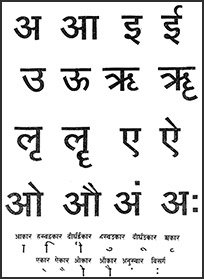Sambodhana, Saṃbodhana: 16 definitions
Introduction:
Sambodhana means something in Hinduism, Sanskrit, Buddhism, Pali, Marathi. If you want to know the exact meaning, history, etymology or English translation of this term then check out the descriptions on this page. Add your comment or reference to a book if you want to contribute to this summary article.
In Hinduism
Vyakarana (Sanskrit grammar)
Source: Wikisource: A dictionary of Sanskrit grammarSaṃbodhana (संबोधन).—Calling or address which is given as one of the additional senses of the nominative case affixes (cf. संबोधने च (saṃbodhane ca) P. II. 3. 47) in addition to those given in the rule प्रातिपदिकार्थलिङ्गपरिमाणवचन-मात्रे प्रथमा (prātipadikārthaliṅgaparimāṇavacana-mātre prathamā) P. II. 3.46; cf. आभिमुख्य-करणं संबोधनम् (ābhimukhya-karaṇaṃ saṃbodhanam) Kas. on P. II. 3.47.

Vyakarana (व्याकरण, vyākaraṇa) refers to Sanskrit grammar and represents one of the six additional sciences (vedanga) to be studied along with the Vedas. Vyakarana concerns itself with the rules of Sanskrit grammar and linguistic analysis in order to establish the correct context of words and sentences.
Shaktism (Shakta philosophy)
Source: Google Books: ManthanabhairavatantramSaṃbodhana (संबोधन) refers to “awakening”, according to the Manthānabhairavatantra, a vast sprawling work that belongs to a corpus of Tantric texts concerned with the worship of the goddess Kubjikā.—Accordingly, “The state of the Gander [i.e., haṃsagati] (arises) when all the energies (of the Moon) have dissolved away. The container of the world of the Gander is the first energy (of the Moon). Fierce (caṇḍā) she is Umā, the New Moon who illumines consciousness. The awakening [i.e., saṃbodhana] of Kaula is its manifestation (udaya) (as) the deity of the group of six (Wheels). The deity is in the Tradition of the Cave and it is she who, by means (of her) modalities, is in the six (Wheels)”.

Shakta (शाक्त, śākta) or Shaktism (śāktism) represents a tradition of Hinduism where the Goddess (Devi) is revered and worshipped. Shakta literature includes a range of scriptures, including various Agamas and Tantras, although its roots may be traced back to the Vedas.
Dharmashastra (religious law)
Source: Oxford Academic: Homo Ritualis: Hindu Ritual and Its Significance to Ritual TheorySambodhana (सम्बोधन) refers to the “ceremonial address”, and represents one of the traditional marriage rituals, according to Dadhirāma Marāsini’s 19th century Vivāhapaddhati (part of his Karmakāṇḍabhāskara) which is based on the Pāraskara-Gṛhyasūtra, a domestic manual in the Mādhyandina school of the Vājasaneyisaṃhitā.—If performed traditionally, high caste marriages among the Parbatiyas (Parbates/Paharis/Pahadis) or Indo-Nepalese people in Nepal are normally executed by following the course of events as presented in marriage manuals. The Sambodhana rite is mentioned under the header called Rules for the marriage (vivāhavidhi): worship of the groom (varapūjana).

Dharmashastra (धर्मशास्त्र, dharmaśāstra) contains the instructions (shastra) regarding religious conduct of livelihood (dharma), ceremonies, jurisprudence (study of law) and more. It is categorized as smriti, an important and authoritative selection of books dealing with the Hindu lifestyle.
Languages of India and abroad
Pali-English dictionary
Source: BuddhaSasana: Concise Pali-English Dictionarysambodhana : (nt.) 1. arousing; 2. the vocative case.
Source: Sutta: The Pali Text Society's Pali-English DictionarySambodhana, (nt.) (saṃ+bodhana) the vocative case VvA. 12, 18. (Page 694)

Pali is the language of the Tipiṭaka, which is the sacred canon of Theravāda Buddhism and contains much of the Buddha’s speech. Closeley related to Sanskrit, both languages are used interchangeably between religions.
Marathi-English dictionary
Source: DDSA: The Molesworth Marathi and English Dictionarysambōdhana (संबोधन).—n (S) Addressing, accosting, calling, calling to or speaking to. 2 In grammar. The power or the sense of the vocative case: also the vocative case, or the signs of it, hē, arē, ahō &c. Oh! holla! 3 An epithet. Ex. tō sujña āhē thōra āhē dhīṭa āhē hīṃ ēvaḍhīṃ tyāsa sambōdhanēṃ kaśālā dētāṃ. 4 Misused by the illiterate for udāharaṇa.
Source: DDSA: The Aryabhusan school dictionary, Marathi-Englishsambōdhana (संबोधन).—n Addressing, accosting. (In grammar) The vocative case. An epithet.
Marathi is an Indo-European language having over 70 million native speakers people in (predominantly) Maharashtra India. Marathi, like many other Indo-Aryan languages, evolved from early forms of Prakrit, which itself is a subset of Sanskrit, one of the most ancient languages of the world.
Sanskrit dictionary
Source: DDSA: The practical Sanskrit-English dictionarySaṃbodhana (संबोधन).—
1) Explaining.
2) Addressing.
3) The vocative case.
4) An epithet (used in calling a person); भूमौ स्थिता रमण नाथ मनोहरेति संबोधनैर्यमधिरोपितवत्यसि द्याम् (bhūmau sthitā ramaṇa nātha manohareti saṃbodhanairyamadhiropitavatyasi dyām) Bv.3.13.
Derivable forms: saṃbodhanam (संबोधनम्).
Source: Cologne Digital Sanskrit Dictionaries: Shabda-Sagara Sanskrit-English DictionarySambodhana (सम्बोधन).—n.
(-naṃ) 1. Calling, addressing, calling to. 2. The vocative case, (in grammar.) E. sam, and budh to know, causal form, aff. lyuṭ .
Source: Cologne Digital Sanskrit Dictionaries: Benfey Sanskrit-English DictionarySaṃbodhana (संबोधन).—i. e. sam-budh + ana, 1. Calling. 2. Addressing,
Saṃbodhana (संबोधन).—[adjective] awakening; [neuter] perceiving, understanding, reminding, also = saṃbuddhi.
Source: Cologne Digital Sanskrit Dictionaries: Monier-Williams Sanskrit-English Dictionary1) Sambodhana (सम्बोधन):—[=sam-bodhana] [from sam-bodha > sam-budh] mfn. (partly [from] [Causal]) awaking, arousing, [Mahābhārata]
2) [v.s. ...] perceiving, noticing, observing, [Mahābhārata]
3) [v.s. ...] recognizing, [Maitrī-upaniṣad]
4) [v.s. ...] the act of causing to know, reminding, [Mahābhārata; Harivaṃśa]
5) [v.s. ...] calling to, [Pāṇini 2-3, 47]
6) [v.s. ...] the vocative case or its termination, [Siddhānta-kaumudī; Subhāṣitāvali]
Source: Cologne Digital Sanskrit Dictionaries: Yates Sanskrit-English DictionarySambodhana (सम्बोधन):—[sa-mbodhana] (naṃ) 1. n. Calling to; the vocative case.
Source: DDSA: Paia-sadda-mahannavo; a comprehensive Prakrit Hindi dictionary (S)Saṃbodhana (संबोधन) in the Sanskrit language is related to the Prakrit word: Saṃbohaṇa.
[Sanskrit to German]
Sanskrit, also spelled संस्कृतम् (saṃskṛtam), is an ancient language of India commonly seen as the grandmother of the Indo-European language family (even English!). Closely allied with Prakrit and Pali, Sanskrit is more exhaustive in both grammar and terms and has the most extensive collection of literature in the world, greatly surpassing its sister-languages Greek and Latin.
Kannada-English dictionary
Source: Alar: Kannada-English corpusSaṃbōdhana (ಸಂಬೋಧನ):—[noun] = ಸಂಬೋಧನೆ [sambodhane].
Kannada is a Dravidian language (as opposed to the Indo-European language family) mainly spoken in the southwestern region of India.
See also (Relevant definitions)
Partial matches: Bodhana, Sha, Sam, Ca.
Starts with: Campotanai, Campotanam, Sambodhana-bhashana, Sambodhana-giti, Sambodhana-karaka, Sambodhanasucaka, Sambodhanavibhakti, Sampotanam.
Ends with: Abhisambodhana, Samyukta-sambodhana, Svarupasambodhana, Svasvabhavasambodhana, Utsambodhana.
Full-text: Sambuddhi, Abhisambodhana, Sambodhanem, Sanyukt-sambodhan, Svarupasambodhana, Sambohana, Svarupasambodhanapancavimshativritti, Abhashana, Paribhashika, Aho.
Relevant text
Search found 6 books and stories containing Sambodhana, Sa-mbodhana, Sam-bodhana, Sambōdhana, Saṃbodhana, Saṃbōdhana; (plurals include: Sambodhanas, mbodhanas, bodhanas, Sambōdhanas, Saṃbodhanas, Saṃbōdhanas). You can also click to the full overview containing English textual excerpts. Below are direct links for the most relevant articles:
Vakyapadiya of Bhartrihari (by K. A. Subramania Iyer)
Verse 3.7.163 < [Book 3 - Pada-kāṇḍa (7): Sādhana-samuddeśa (On the Means)]
Verse 3.10.5 < [Book 3 - Pada-kāṇḍa (10): Puruṣa-samuddeśa (On Person)]
Verse 2.370 < [Book 2 - Vākya-kāṇḍa]
Brihad Bhagavatamrita (commentary) (by Śrī Śrīmad Bhaktivedānta Nārāyana Gosvāmī Mahārāja)
Verse 2.4.243 < [Chapter 4 - Vaikuṇṭha (the spiritual world)]
Manusmriti with the Commentary of Medhatithi (by Ganganatha Jha)
Verse 1.2 < [Section I - Question of the Sages]
Dvisahasri of Tembesvami (Summary and Study) (by Upadhyay Mihirkumar Sudhirbhai)
Lord Dattātreya’s incarnations < [Introduction]
Apadana commentary (Atthakatha) (by U Lu Pe Win)
Commentary on Biography of the thera Kāḷudāyī < [Chapter 4 - Kuṇḍadhānavagga (section on Kuṇḍadhāna)]
The Sarva-Darsana-Samgraha (by E. B. Cowell)